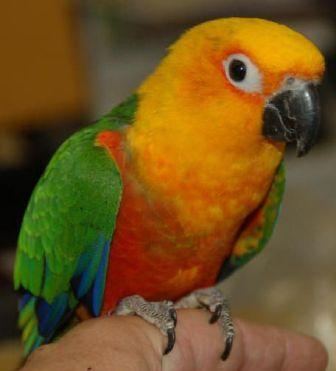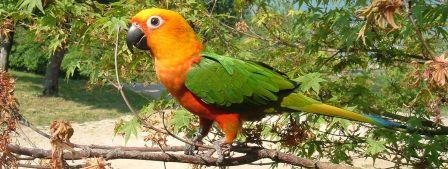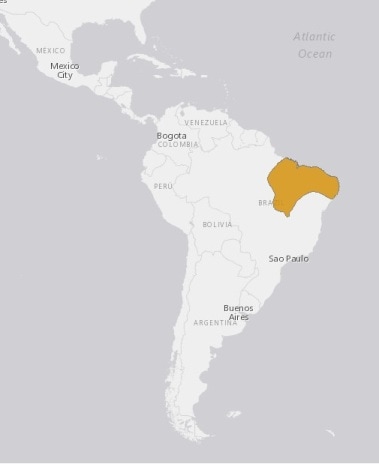Jenday ConureAratinga jandaya |

Custom Search
|
|
The Jenday Conure (Aratinga jandaya) also known as Jandaya Parakeet is a small Neotropical bird found in northeastern Brazil. The species as a massive range comprising the states of Maranhão, Piauí, Ceará, Tocantins and some regions of Pará and are considered relatively common in the wild.
These beautiful little conures inhabit lowland deciduous woodland, edges of rainforests, coconut palm groves and forest clearings. It's probably one of the few species that has in some way benefited from forest clearing and natural habitat modification. These birds are very social and generally live in pairs or small flocks of 10 to 15 birds. The Jenday Conure has reddish orange stomachs and a long green tail with the end of the feathers tinged in an iridescent blue. The wings and vent are also green, while their head, neck and, shoulders are yellow. The cheeks are orange and the eyes are surrounded by a white ring. Just like on the tail, the tips of the wings are also blue colored. Juveniles have a less vibrant green color but as they mature their colors will gradually get brighter. Their full adult coloration is attained at about one or two years of age. Like all conures in the Aratinga genus, their beaks is black, just like their feet. Adult Jenday conures measure about 12 inches (30 cm) in length and weigh on average between 4 and 5 ounces (125-140 gm).
The Jenday Conure belongs to the Aratinga solstitialis complex, a group of very closely related parakeets. They are closely related to the sun conure (Aratinga solstitialis) even sometimes considered to be one of its subspecies.
It's easy to mistaken the 2 species since they look very much the same, particularly with young Sun Conures before their first molt. But somewhat obvious differences are the blue tipped wings and tail feathers of the Jenday Conure. Like other conure or parakeet species the Jenday Conure is often kept as a pet and their lifespan in captivity reaches up to 30 years. These little birds are very intelligent and can even be trained to perform some "tricks" using some positive reinforcement. Their call is a very loud, shrill, and in captivity they often learn to mimic human sounds including words or even small phrases. Although they aren't known for their talking ability. These birds are also known by other colloquial names like flaming conure or yellow-headed conure. It is a little beautiful bird and the Jenday Conure also costs much less than other conure species like the Golden Conure or the Sun conure. Subspecies / Taxonomy / Etymology There are no subspecies recognized by scientists. Just like other animal species, the taxonomy of the Jenday Conure and other closely related conure species has been somewhat difficult. The German naturalist, Georg Marcgraf was the first to describe a bird called "jendaya" back in 1638. But it was only classified in 1788 as Psittacus jandaya by Johann Gmelin a German naturalist. After several revisions, the American ornithologist Robert Ridgway placed them in the genus Aratinga in 1916. Sometimes they are considered a subspecies of the Sun Conure (Aratinga solstitialis), while Thomas Arndt, a German Ornithologist, lists them as a subspecies of the golden-capped conure (Aratinga auricapillus). The species scientific name derives from the conjunction of Old Tupi words to form Aratinga, Ará meaning "big noisy bird" and tinga meaning "bright". While jandaya which was originally jandaia is the Old Tupi meaning small parrot or conure. Diet / Feeding The Jenday Conure favorite foods in the wild include several fruits including palm nuts, cashew apples, and mangoes. However, they also have a tendency to feed on human cultivated plants like rice or maize. As pets, they eat seeds, pellets, fresh fruits like chopped kiwis, apples or melons and vegetables. But there are somethings we eat that are toxic to them including caffeine or chocolate and avocados. Reproduction Jenday Conures are considered a cavity-nesting bird species. Usually, they make their nest in tree hollows in dead trees, normally in a location at least 50 feet (15 m) high. Females lay between 2 and 4 white eggs, in the hollowed out nest, with the incubation period lasting about 26 or 27 days. They are wonderful parents and the chicks are fed by both parents and leave the nest or fledge at around 7 weeks old. They are quite common in captivity and with the right conditions they will also easily breed. There's even a hybrid conure resulting from the crossing of a Jenday Conure with a Nanday Conure (Aratinga nenday). Conservation status and major threats The Jenday Conure is listed as least concern species by IUCN and is also listed on CITES Appendix II. The species is protected under the Brazil Wildlife Protection Act and their export and trade were forbidden. Their population in the wild has not been clearly quantified, but they were described as "rare" in parts of their range by 2 field surveys.
|
Did You Know?
The deathstalker scorpion (Leiurus quinquestriatus) is regarded as one of the most dangerous scorpions in the world. Scientific classification
Kingdom: Animalia Phylum: Chordata Class: Aves Order: Psittaciformes Superfamily: Psittacoidea Family: Psittacidae Subfamily: Arinae Tribe: Arini Genus: Aratinga Species: A. jandaya |



